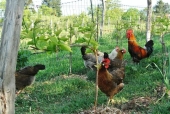In his essay titled "The Native Grasses and What They Mean" (found in the book The Gift of Good Land), Wendell Berry mentions the traditional corn planting and harvesting practices of a companion of his. I will quote at length:
...Tim described for us his father's way of managing his cornfields. In the fields nearest the house, in addition to corn, he planted beans and pumpkins. He sowed cowpeas between the corn hills to improve the soil. Before picking the corn, he sowed redtop to provide a winter cover. He harvested the corn in three stages. First, he stripped off the blades below the ear; this was called "blade fodder." Next, he cut off the stalk above the ear, which was "top fodder." Both kinds of fodder were carefully stored for winter feed. Finally he harvested the ears.
Can anybody give any insight into the timing of these successive harvests? Were they all completed as the grain was ripe, or did they occur over a period of time? I'd assume the latter; otherwise there would seem to be no point in having an order to the harvest. But when in the growing season would these harvests have occurred?









